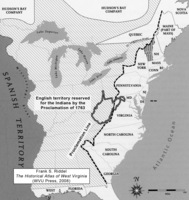 | Back to e-WV
| Back to e-WV
 The West Virginia Encyclopedia
The West Virginia Encyclopedia
 | Back to e-WV
| Back to e-WV
 The West Virginia Encyclopedia
The West Virginia Encyclopedia

Settlement west of the Allegheny Mountains was sparse in the mid-1700s due to the threat of attacks by Indians and disputes between the English and French over control of the region. The British secured their rights to the area by their victory in the French and Indian War. As settlers prepared to pour into the region following the end of the war in 1763, the English government feared additional conflicts with Indians, which could have disrupted their profitable fur trade in the Ohio Valley. On October 7, a proclamation by King George III prohibited all settlement west of the Alleghenies. The Proclamation Line ran along the divide between the eastern rivers and the Ohio watershed, leaving only the Eastern Panhandle of modern West Virginia open to settlement, plus a fraction of Monroe County.
Settlers, for the most part, abided by the proclamation, although speculators, such as George Washington, took advantage of the situation by claiming large tracts of land for themselves. The two British agents assigned to enforce the proclamation, Sir William Johnson and Col. John Stuart, negotiated two treaties in 1768 that reopened the region to settlement. The Treaty of Hard Labor with the Cherokee and the Treaty of Fort Stanwix with the Iroquois cleared the way for settlement in all but the extreme southern part of present West Virginia. As a result, in spring 1769, numerous communities sprang into existence virtually overnight.
Written by Stan Bumgardner
Rice, Otis K. & Stephen W. Brown. West Virginia: A History. Lexington: University Press of Kentucky, 1993.